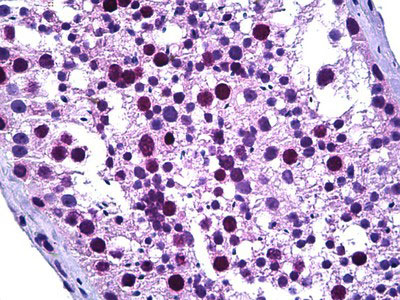TPX2 Antibody (aa301-350)
Rabbit Polyclonal Antibody
- SPECIFICATION
- CITATIONS
- PROTOCOLS
- BACKGROUND

Application
| WB, IHC-P, E |
|---|---|
| Primary Accession | Q9ULW0 |
| Reactivity | Human, Mouse |
| Host | Rabbit |
| Clonality | Polyclonal |
| Calculated MW | 86kDa |
| Dilution | ELISA (1:1000), IHC-P (10 µg/ml), WB (1:500-1:1000) |
| Gene ID | 22974 |
|---|---|
| Other Names | Targeting protein for Xklp2, Differentially expressed in cancerous and non-cancerous lung cells 2, DIL-2, Hepatocellular carcinoma-associated antigen 519, Hepatocellular carcinoma-associated antigen 90, Protein fls353, Restricted expression proliferation-associated protein 100, p100, TPX2, C20orf1, C20orf2, DIL2, HCA519 |
| Target/Specificity | TPX2 Antibody detects endogenous levels of total TPX2 protein. |
| Reconstitution & Storage | Short term 4°C, long term aliquot and store at -20°C, avoid freeze thaw cycles. |
| Precautions | TPX2 Antibody (aa301-350) is for research use only and not for use in diagnostic or therapeutic procedures. |
| Name | TPX2 |
|---|---|
| Synonyms | C20orf1, C20orf2, DIL2, HCA519 |
| Function | Spindle assembly factor required for normal assembly of mitotic spindles. Required for normal assembly of microtubules during apoptosis. Required for chromatin and/or kinetochore dependent microtubule nucleation. Mediates AURKA localization to spindle microtubules (PubMed:18663142, PubMed:19208764, PubMed:37728657). Activates AURKA by promoting its autophosphorylation at 'Thr-288' and protects this residue against dephosphorylation (PubMed:18663142, PubMed:19208764). TPX2 is inactivated upon binding to importin-alpha (PubMed:26165940). At the onset of mitosis, GOLGA2 interacts with importin-alpha, liberating TPX2 from importin-alpha, allowing TPX2 to activate AURKA kinase and stimulate local microtubule nucleation (PubMed:26165940). |
| Cellular Location | Nucleus. Cytoplasm, cytoskeleton, spindle. Cytoplasm, cytoskeleton, spindle pole. Note=During mitosis it is strictly associated with the spindle pole and with the mitotic spindle, whereas during S and G2, it is diffusely distributed throughout the nucleus. Is released from the nucleus in apoptotic cells and is detected on apoptotic microtubules. |
| Tissue Location | Expressed in lung carcinoma cell lines but not in normal lung tissues |

Thousands of laboratories across the world have published research that depended on the performance of antibodies from Abcepta to advance their research. Check out links to articles that cite our products in major peer-reviewed journals, organized by research category.
info@abcepta.com, and receive a free "I Love Antibodies" mug.
Provided below are standard protocols that you may find useful for product applications.
Background
Spindle assembly factor. Required for normal assembly of mitotic spindles. Required for normal assembly of microtubules during apoptosis. Required for chromatin and/or kinetochore dependent microtubule nucleation. Mediates AURKA localization to spindle microtubules. Activates AURKA by promoting its autophosphorylation at 'Thr-288' and protects this residue against dephosphorylation.
References
Manda R.,et al.Genomics 61:5-14(1999).
Zhang Y.,et al.Cytogenet. Cell Genet. 84:182-183(1999).
Nezu J.,et al.Submitted (MAR-1999) to the EMBL/GenBank/DDBJ databases.
Wang Y.,et al.J. Immunol. 169:1102-1109(2002).
Deloukas P.,et al.Nature 414:865-871(2001).
If you have used an Abcepta product and would like to share how it has performed, please click on the "Submit Review" button and provide the requested information. Our staff will examine and post your review and contact you if needed.
If you have any additional inquiries please email technical services at tech@abcepta.com.













 Foundational characteristics of cancer include proliferation, angiogenesis, migration, evasion of apoptosis, and cellular immortality. Find key markers for these cellular processes and antibodies to detect them.
Foundational characteristics of cancer include proliferation, angiogenesis, migration, evasion of apoptosis, and cellular immortality. Find key markers for these cellular processes and antibodies to detect them. The SUMOplot™ Analysis Program predicts and scores sumoylation sites in your protein. SUMOylation is a post-translational modification involved in various cellular processes, such as nuclear-cytosolic transport, transcriptional regulation, apoptosis, protein stability, response to stress, and progression through the cell cycle.
The SUMOplot™ Analysis Program predicts and scores sumoylation sites in your protein. SUMOylation is a post-translational modification involved in various cellular processes, such as nuclear-cytosolic transport, transcriptional regulation, apoptosis, protein stability, response to stress, and progression through the cell cycle. The Autophagy Receptor Motif Plotter predicts and scores autophagy receptor binding sites in your protein. Identifying proteins connected to this pathway is critical to understanding the role of autophagy in physiological as well as pathological processes such as development, differentiation, neurodegenerative diseases, stress, infection, and cancer.
The Autophagy Receptor Motif Plotter predicts and scores autophagy receptor binding sites in your protein. Identifying proteins connected to this pathway is critical to understanding the role of autophagy in physiological as well as pathological processes such as development, differentiation, neurodegenerative diseases, stress, infection, and cancer.



